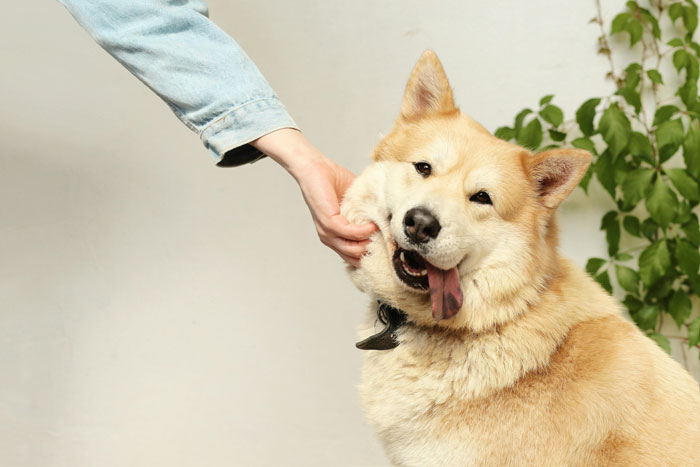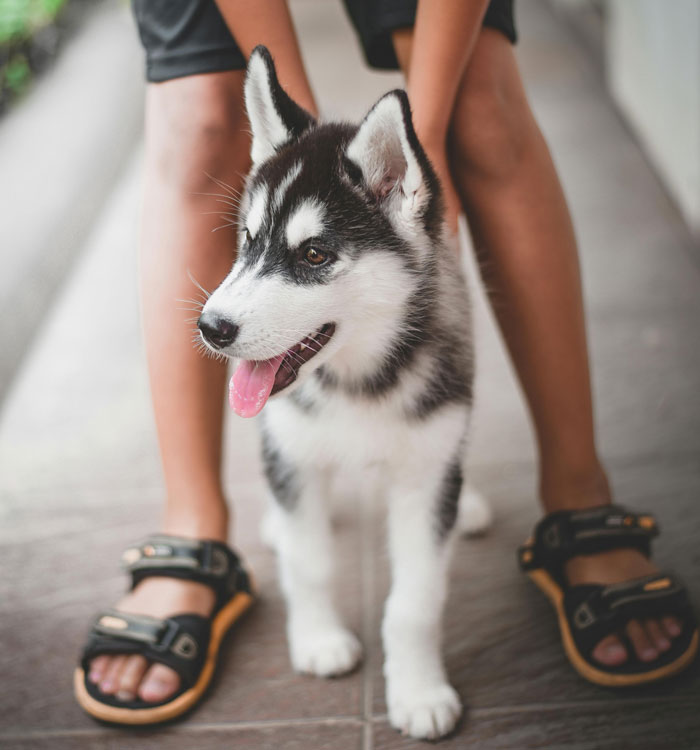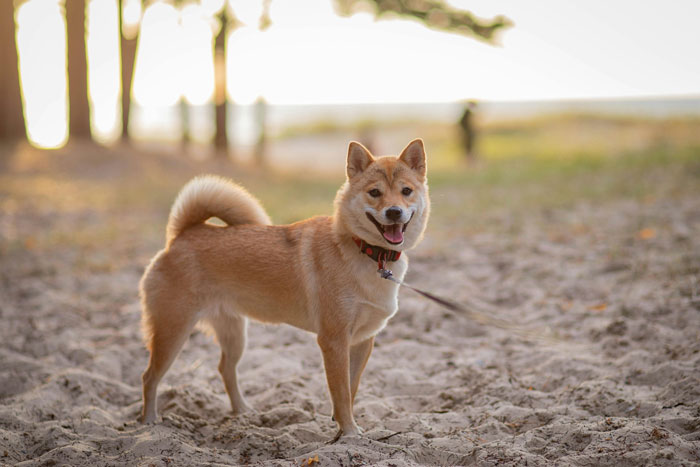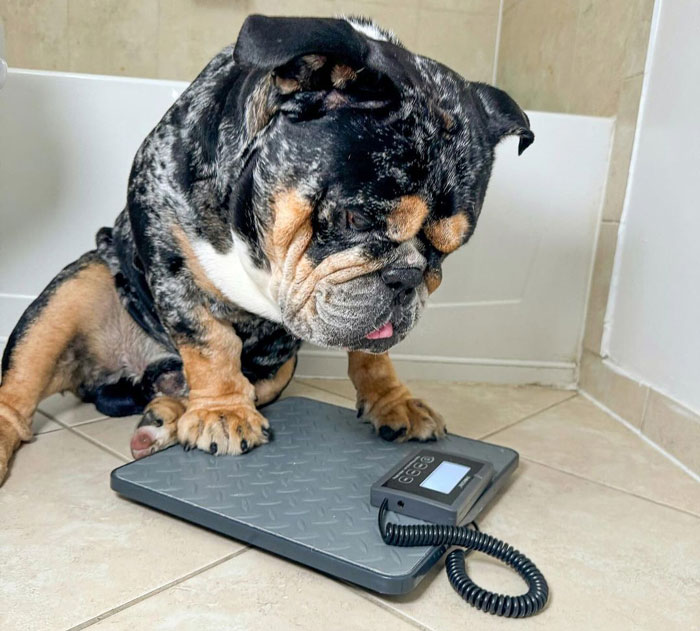Maintaining a healthy dog weight is one of the most impactful things you can do to ensure your dog’s longevity, well-being, and overall quality of life. Dogs at an ideal weight have a significantly reduced risk of serious diseases like arthritis, diabetes, and heart conditions. They can even live up to two years longer than their overweight counterparts.
However, a dog’s “ideal weight” isn’t just a number — several factors, including breed, activity level, age, and individual build influence it. For instance, breeds like greyhounds and whippets naturally build leaner than stockier breeds. The most effective approach to determining yourdog’s ideal body weightcombines visual cues with a tool called Body Condition Scoring (BCS).
The information provided herein is for informational purposes only. Please refer to ourdisclaimerfor more details..
Table of ContentsHow to Determine Ideal WeightVisual InspectionBody Condition Scoring (BCS) – More Accurate AssessmentWhat is BCS?Why use BCS?How to Perform an At-Home BCS AssessmentSimplified BCS 9-point ScaleThe Ideal BCSThe Importance of Breed StandardsWhere to Find Breed InformationHow to Calculate Your Dog’s Target WeightSteps:Understanding the FormulaExample with a 60-pound Dog:Additional Factors Influencing Healthy WeightHow Much Should My Dog Weigh?Ideal Weight Chart: Popular Dog BreedsWhy It’s Important to Know Your Dog’s Ideal Weight
How to Determine Ideal Weight
We’ll show you simple checks to assess your dog’s weight and introduce Body Condition Scoring (BCS) for a complete picture.
Visual Inspection
Image credits:Maksim Goncharenok

While charts can be a starting point, the best way to understand your dog’s weight is through simple visual checks. Here’s how to examine three key areas:
The Rib Test
Image credits:Rattasat

Place your hands on both sides of your dog’s ribcage and gently run your fingers over their ribs. In a dog at an ideal weight, you should be able to feel their ribs easily, but they won’t be overly prominent.
There should be a slight layer of fat covering them. If the ribs are very visible or feel sharp with no fat covering, your dog might be underweight.
On the other hand, if you have to press hard to feel the ribs through a thick layer of fat, your dog is likely overweight.
The Overhead View
Image credits:freepik

Stand directly above your dog and look at their overall shape. Ideally, you want to see a gentle inward curve behind the ribs, creating a subtle waistline. This is the classic “hourglass” figure.
An overweight dog will lose this definition, appearing more barrel-shaped or bulging outward at the waist.
An underweight dog will have an exaggerated inward curve or “tucked” waist. Keep in mind that natural variations exist between breeds. A Greyhound’s deep chest or aBulldog’sstocky build will influence their overhead shape, so consider your dog’s breed.
The Side Profile
Image credits:Valeria Boltneva

Look at your dog from the side, focusing on their belly area. Dogs at a healthy weight will have a visible “abdominal tuck” where the belly slopes gently upward after the ribs.
An overweight dog might have a sagging belly, a straight line from ribs to rear, or even a belly that bulges downwards. In an underweight dog, this abdominal tuck will be extreme, and the dog may appear gaunt.
These visual cues are a great starting point for understanding your dog’s weight status. To get the most precise assessment, combine these observations with a tool called Body Condition Scoring (BCS), which we’ll cover in the next section.
Body Condition Scoring (BCS) – More Accurate Assessment
Visual inspections are great, but for the most precise way to gauge your dog’s weight, it’s time to learn Body Condition Scoring (BCS). Veterinarians and animal experts worldwide use this tool.
What is BCS?
Consider BCS like a simple scale to determine if your dog is underweight, overweight, or at an ideal weight. There are two main versions:
Both scales rate your dog based on the visibility and feel of key areas like ribs, waistline, and abdominal fat.
Why use BCS?
How to Perform an At-Home BCS Assessment
Get comfortable with BCS. It may take some practice to master. Always discuss your dog’s BCS with your veterinarian. They can provide the most accurate interpretation and guidance, especially if your dog has any underlying health conditions.
Simplified BCS 9-point Scale
The Ideal BCS
On both the 5-point and 9-point scales, the middle scores represent an ideal body condition. For example:
Remember, BCS and your vet’s expertise are the key to understanding and maintaining your dog’s healthiest weight!
The Importance of Breed Standards
Breed standards, which describe a breed’s ideal traits, often include a suggested weight range. Think of these ranges as a general guideline rather than an absolute rule. Even within a breed, a dog’s ideal weight depends on their size, build, and activity level. Always consider your individual dog and prioritize using visual checks and Body Condition Scoring (BCS).
Where to Find Breed Information
How to Calculate Your Dog’s Target Weight
Image credits:i.am.kingkai

Now that you’ve determined your dog’s Body Condition Score (BCS), you can use it to estimate their ideal weight. Researchers at the University of Liverpool and Royal Canin developed this method.
Steps:
Let’s say your dog’s current weight is 60 pounds. Then: 0.769 x 60 pounds = 46.14 pounds (round to 46.1 pounds).
Understanding the Formula
Here’s the formula used to calculate your dog’s target weight:
Target Weight = (Current Weight x 100) / (100 + (Starting BCS – 5) x 10)
Example with a 60-pound Dog:
Let’s use this formula with our 60-pound dog with a BCS of 8:
Target Weight = (60 x 100) / (100 + (8 – 5) x 10)
Target Weight = 6000 / (100 + 30)
Target Weight = 6000 / 130
Target Weight = 46.15 pounds (round to 46.2 pounds)
Conclusion:Based on this calculation, the ideal target weight for this dog would be approximately 46.15 kg. Since the starting BCS is 8 (indicating the dog is overweight), this would involvea weight loss program.
It’s crucial to consult with your veterinarian to determine a safe and healthy weight loss plan for your dog. They can provide a personalized target weight goal and guidance onadjusting dog foodand exercise.
Additional Factors Influencing Healthy Weight
While BCS and breed standards are key tools, it’s essential to remember that several other factors play a role in your dog’s ideal weight.
How Much Should My Dog Weigh?
Every dog is differentso that healthy weights can vary even within the same breed. There are a few ways to get an idea of your dog’s potential adult size and weight:
If you don’t know the parents’ information, or if your dog falls outside the breed averages, don’t worry! Your veterinarian is the best resource. They can assess your dog’s body condition and overall health, alongside breed considerations, to determine their ideal weight range.
Ideal Weight Chart: Popular Dog Breeds
Breed weight ranges can be a helpful starting point, but individual dogs may vary. The following chart provides estimated weight ranges for popular breeds.
BreedMale (pounds/kg)Female (pounds/kg)Labrador Retriever65-80 (29-36)55-70 (25-32)German Shepherd Dog65-90 (29-41)50-70 (23-32)Golden Retriever65-75 (29-34)55-65 (25-29)French Bulldogunder 28 (under 13)under 28 (under 13)Bulldog50 (23)40 (18)Poodle (Standard)60-70 (27-32)40-50 (18-23)Poodle (Miniature)10-15 (4.5-6.8)10-15 (4.5-6.8)Poodle (Toy)4-6 (1.8-2.7)4-6 (1.8-2.7)Beagle (13″ & under)under 20 (under 9)under 20 (under 9)Beagle (13-15″)20-30 (9-14)20-30 (9-14)Rottweiler95-135 (43-61)80-100 (36-45)German Shorthaired Pointer55-70 (25-32)45-60 (20-27)Dachshund (Standard)16-32 (7-15)16-32 (7-15)Dachshund (Miniature)11 & under (under 5)11 & under (under 5)Pembroke Welsh Corgiup to 30 (up to 14)up to 28 (up to 13)Australian Shepherd50-65 (23-29)40-55 (18-25)Yorkshire Terrier7 (3.2)7 (3.2)Boxer65-80 (29-36)50-65 (23-29)Doberman Pinscher75-100 (34-45)60-90 (27-41)Cavalier King Charles Spaniel13-18 (5.9-8.2)13-18 (5.9-8.2)Miniature Schnauzer11-20 (5-9)11-20 (5-9)Great Dane140-175 (64-79)110-140 (50-64)Siberian Husky45-60 (20-27)35-50 (16-23)Bernese Mountain Dog80-115 (36-52)70-95 (32-43)Cocker Spaniel25-30 (11-14)20-25 (9-11)Brittany30-40 (14-18)30-40 (14-18)Boston Terrier12-25 (5.4-11)12-25 (5.4-11)Havanese7-13 (3.2-5.9)7-13 (3.2-5.9)Shetland Sheepdog15-25 (6.8-11)15-25 (6.8-11)Shih Tzu9-16 (4-7)9-16 (4-7)Pug14-18 (6.4-8.2)14-18 (6.4-8.2)Basset Hound40-65 (18-29)40-65 (18-29)Bichon Frise12-18 (5.4-8.2)12-18 (5.4-8.2)
BreedLabrador RetrieverMale (pounds/kg)65-80 (29-36)Female (pounds/kg)55-70 (25-32)BreedGerman Shepherd DogMale (pounds/kg)65-90 (29-41)Female (pounds/kg)50-70 (23-32)BreedGolden RetrieverMale (pounds/kg)65-75 (29-34)Female (pounds/kg)55-65 (25-29)BreedFrench BulldogMale (pounds/kg)under 28 (under 13)Female (pounds/kg)under 28 (under 13)BreedBulldogMale (pounds/kg)50 (23)Female (pounds/kg)40 (18)BreedPoodle (Standard)Male (pounds/kg)60-70 (27-32)Female (pounds/kg)40-50 (18-23)BreedPoodle (Miniature)Male (pounds/kg)10-15 (4.5-6.8)Female (pounds/kg)10-15 (4.5-6.8)BreedPoodle (Toy)Male (pounds/kg)4-6 (1.8-2.7)Female (pounds/kg)4-6 (1.8-2.7)BreedBeagle (13″ & under)Male (pounds/kg)under 20 (under 9)Female (pounds/kg)under 20 (under 9)BreedBeagle (13-15″)Male (pounds/kg)20-30 (9-14)Female (pounds/kg)20-30 (9-14)BreedRottweilerMale (pounds/kg)95-135 (43-61)Female (pounds/kg)80-100 (36-45)BreedGerman Shorthaired PointerMale (pounds/kg)55-70 (25-32)Female (pounds/kg)45-60 (20-27)BreedDachshund (Standard)Male (pounds/kg)16-32 (7-15)Female (pounds/kg)16-32 (7-15)BreedDachshund (Miniature)Male (pounds/kg)11 & under (under 5)Female (pounds/kg)11 & under (under 5)BreedPembroke Welsh CorgiMale (pounds/kg)up to 30 (up to 14)Female (pounds/kg)up to 28 (up to 13)BreedAustralian ShepherdMale (pounds/kg)50-65 (23-29)Female (pounds/kg)40-55 (18-25)BreedYorkshire TerrierMale (pounds/kg)7 (3.2)Female (pounds/kg)7 (3.2)BreedBoxerMale (pounds/kg)65-80 (29-36)Female (pounds/kg)50-65 (23-29)BreedDoberman PinscherMale (pounds/kg)75-100 (34-45)Female (pounds/kg)60-90 (27-41)BreedCavalier King Charles SpanielMale (pounds/kg)13-18 (5.9-8.2)Female (pounds/kg)13-18 (5.9-8.2)BreedMiniature SchnauzerMale (pounds/kg)11-20 (5-9)Female (pounds/kg)11-20 (5-9)BreedGreat DaneMale (pounds/kg)140-175 (64-79)Female (pounds/kg)110-140 (50-64)BreedSiberian HuskyMale (pounds/kg)45-60 (20-27)Female (pounds/kg)35-50 (16-23)BreedBernese Mountain DogMale (pounds/kg)80-115 (36-52)Female (pounds/kg)70-95 (32-43)BreedCocker SpanielMale (pounds/kg)25-30 (11-14)Female (pounds/kg)20-25 (9-11)BreedBrittanyMale (pounds/kg)30-40 (14-18)Female (pounds/kg)30-40 (14-18)BreedBoston TerrierMale (pounds/kg)12-25 (5.4-11)Female (pounds/kg)12-25 (5.4-11)BreedHavaneseMale (pounds/kg)7-13 (3.2-5.9)Female (pounds/kg)7-13 (3.2-5.9)BreedShetland SheepdogMale (pounds/kg)15-25 (6.8-11)Female (pounds/kg)15-25 (6.8-11)BreedShih TzuMale (pounds/kg)9-16 (4-7)Female (pounds/kg)9-16 (4-7)BreedPugMale (pounds/kg)14-18 (6.4-8.2)Female (pounds/kg)14-18 (6.4-8.2)BreedBasset HoundMale (pounds/kg)40-65 (18-29)Female (pounds/kg)40-65 (18-29)BreedBichon FriseMale (pounds/kg)12-18 (5.4-8.2)Female (pounds/kg)12-18 (5.4-8.2)
BreedLabrador RetrieverMale (pounds/kg)65-80 (29-36)Female (pounds/kg)55-70 (25-32)
BreedLabrador Retriever
Breed
Labrador Retriever
Male (pounds/kg)65-80 (29-36)
Male (pounds/kg)
65-80 (29-36)
Female (pounds/kg)55-70 (25-32)
Female (pounds/kg)
55-70 (25-32)
BreedGerman Shepherd DogMale (pounds/kg)65-90 (29-41)Female (pounds/kg)50-70 (23-32)
BreedGerman Shepherd Dog
German Shepherd Dog
Male (pounds/kg)65-90 (29-41)
65-90 (29-41)
Female (pounds/kg)50-70 (23-32)
50-70 (23-32)
BreedGolden RetrieverMale (pounds/kg)65-75 (29-34)Female (pounds/kg)55-65 (25-29)
BreedGolden Retriever
Golden Retriever
Male (pounds/kg)65-75 (29-34)
65-75 (29-34)
Female (pounds/kg)55-65 (25-29)
55-65 (25-29)
BreedFrench BulldogMale (pounds/kg)under 28 (under 13)Female (pounds/kg)under 28 (under 13)
BreedFrench Bulldog
French Bulldog
Male (pounds/kg)under 28 (under 13)
under 28 (under 13)
Female (pounds/kg)under 28 (under 13)
BreedBulldogMale (pounds/kg)50 (23)Female (pounds/kg)40 (18)
BreedBulldog
Bulldog
Male (pounds/kg)50 (23)
50 (23)
Female (pounds/kg)40 (18)
40 (18)
BreedPoodle (Standard)Male (pounds/kg)60-70 (27-32)Female (pounds/kg)40-50 (18-23)
BreedPoodle (Standard)
Poodle (Standard)
Male (pounds/kg)60-70 (27-32)
60-70 (27-32)
Female (pounds/kg)40-50 (18-23)
40-50 (18-23)
BreedPoodle (Miniature)Male (pounds/kg)10-15 (4.5-6.8)Female (pounds/kg)10-15 (4.5-6.8)
BreedPoodle (Miniature)
Poodle (Miniature)
Male (pounds/kg)10-15 (4.5-6.8)
10-15 (4.5-6.8)
Female (pounds/kg)10-15 (4.5-6.8)
BreedPoodle (Toy)Male (pounds/kg)4-6 (1.8-2.7)Female (pounds/kg)4-6 (1.8-2.7)
BreedPoodle (Toy)
Poodle (Toy)
Male (pounds/kg)4-6 (1.8-2.7)
4-6 (1.8-2.7)
Female (pounds/kg)4-6 (1.8-2.7)
BreedBeagle (13″ & under)Male (pounds/kg)under 20 (under 9)Female (pounds/kg)under 20 (under 9)
BreedBeagle (13″ & under)
Beagle (13″ & under)
Male (pounds/kg)under 20 (under 9)
under 20 (under 9)
Female (pounds/kg)under 20 (under 9)
BreedBeagle (13-15″)Male (pounds/kg)20-30 (9-14)Female (pounds/kg)20-30 (9-14)
BreedBeagle (13-15″)
Beagle (13-15″)
Male (pounds/kg)20-30 (9-14)
20-30 (9-14)
Female (pounds/kg)20-30 (9-14)
BreedRottweilerMale (pounds/kg)95-135 (43-61)Female (pounds/kg)80-100 (36-45)
BreedRottweiler
Rottweiler
Male (pounds/kg)95-135 (43-61)
95-135 (43-61)
Female (pounds/kg)80-100 (36-45)
80-100 (36-45)
BreedGerman Shorthaired PointerMale (pounds/kg)55-70 (25-32)Female (pounds/kg)45-60 (20-27)
BreedGerman Shorthaired Pointer
German Shorthaired Pointer
Male (pounds/kg)55-70 (25-32)
Female (pounds/kg)45-60 (20-27)
45-60 (20-27)
BreedDachshund (Standard)Male (pounds/kg)16-32 (7-15)Female (pounds/kg)16-32 (7-15)
BreedDachshund (Standard)
Dachshund (Standard)
Male (pounds/kg)16-32 (7-15)
16-32 (7-15)
Female (pounds/kg)16-32 (7-15)
BreedDachshund (Miniature)Male (pounds/kg)11 & under (under 5)Female (pounds/kg)11 & under (under 5)
BreedDachshund (Miniature)
Dachshund (Miniature)
Male (pounds/kg)11 & under (under 5)
11 & under (under 5)
Female (pounds/kg)11 & under (under 5)
BreedPembroke Welsh CorgiMale (pounds/kg)up to 30 (up to 14)Female (pounds/kg)up to 28 (up to 13)
BreedPembroke Welsh Corgi
Pembroke Welsh Corgi
Male (pounds/kg)up to 30 (up to 14)
up to 30 (up to 14)
Female (pounds/kg)up to 28 (up to 13)
up to 28 (up to 13)
BreedAustralian ShepherdMale (pounds/kg)50-65 (23-29)Female (pounds/kg)40-55 (18-25)
BreedAustralian Shepherd
Australian Shepherd
Male (pounds/kg)50-65 (23-29)
50-65 (23-29)
Female (pounds/kg)40-55 (18-25)
40-55 (18-25)
BreedYorkshire TerrierMale (pounds/kg)7 (3.2)Female (pounds/kg)7 (3.2)
BreedYorkshire Terrier
Yorkshire Terrier
Male (pounds/kg)7 (3.2)
7 (3.2)
Female (pounds/kg)7 (3.2)
BreedBoxerMale (pounds/kg)65-80 (29-36)Female (pounds/kg)50-65 (23-29)
BreedBoxer
Boxer
Female (pounds/kg)50-65 (23-29)
BreedDoberman PinscherMale (pounds/kg)75-100 (34-45)Female (pounds/kg)60-90 (27-41)
BreedDoberman Pinscher
Doberman Pinscher
Male (pounds/kg)75-100 (34-45)
75-100 (34-45)
Female (pounds/kg)60-90 (27-41)
60-90 (27-41)
BreedCavalier King Charles SpanielMale (pounds/kg)13-18 (5.9-8.2)Female (pounds/kg)13-18 (5.9-8.2)
BreedCavalier King Charles Spaniel
Cavalier King Charles Spaniel
Male (pounds/kg)13-18 (5.9-8.2)
13-18 (5.9-8.2)
Female (pounds/kg)13-18 (5.9-8.2)
BreedMiniature SchnauzerMale (pounds/kg)11-20 (5-9)Female (pounds/kg)11-20 (5-9)
BreedMiniature Schnauzer
Miniature Schnauzer
Male (pounds/kg)11-20 (5-9)
11-20 (5-9)
Female (pounds/kg)11-20 (5-9)
BreedGreat DaneMale (pounds/kg)140-175 (64-79)Female (pounds/kg)110-140 (50-64)
BreedGreat Dane
Great Dane
Male (pounds/kg)140-175 (64-79)
140-175 (64-79)
Female (pounds/kg)110-140 (50-64)
110-140 (50-64)
BreedSiberian HuskyMale (pounds/kg)45-60 (20-27)Female (pounds/kg)35-50 (16-23)
BreedSiberian Husky
Siberian Husky
Male (pounds/kg)45-60 (20-27)
Female (pounds/kg)35-50 (16-23)
35-50 (16-23)
BreedBernese Mountain DogMale (pounds/kg)80-115 (36-52)Female (pounds/kg)70-95 (32-43)
BreedBernese Mountain Dog
Bernese Mountain Dog
Male (pounds/kg)80-115 (36-52)
80-115 (36-52)
Female (pounds/kg)70-95 (32-43)
70-95 (32-43)
BreedCocker SpanielMale (pounds/kg)25-30 (11-14)Female (pounds/kg)20-25 (9-11)
BreedCocker Spaniel
Cocker Spaniel
Male (pounds/kg)25-30 (11-14)
25-30 (11-14)
Female (pounds/kg)20-25 (9-11)
20-25 (9-11)
BreedBrittanyMale (pounds/kg)30-40 (14-18)Female (pounds/kg)30-40 (14-18)
BreedBrittany
Brittany
Male (pounds/kg)30-40 (14-18)
30-40 (14-18)
Female (pounds/kg)30-40 (14-18)
BreedBoston TerrierMale (pounds/kg)12-25 (5.4-11)Female (pounds/kg)12-25 (5.4-11)
BreedBoston Terrier
Boston Terrier
Male (pounds/kg)12-25 (5.4-11)
12-25 (5.4-11)
Female (pounds/kg)12-25 (5.4-11)
BreedHavaneseMale (pounds/kg)7-13 (3.2-5.9)Female (pounds/kg)7-13 (3.2-5.9)
BreedHavanese
Havanese
Male (pounds/kg)7-13 (3.2-5.9)
7-13 (3.2-5.9)
Female (pounds/kg)7-13 (3.2-5.9)
BreedShetland SheepdogMale (pounds/kg)15-25 (6.8-11)Female (pounds/kg)15-25 (6.8-11)
BreedShetland Sheepdog
Shetland Sheepdog
Male (pounds/kg)15-25 (6.8-11)
15-25 (6.8-11)
Female (pounds/kg)15-25 (6.8-11)
BreedShih TzuMale (pounds/kg)9-16 (4-7)Female (pounds/kg)9-16 (4-7)
BreedShih Tzu
Shih Tzu
Male (pounds/kg)9-16 (4-7)
9-16 (4-7)
Female (pounds/kg)9-16 (4-7)
BreedPugMale (pounds/kg)14-18 (6.4-8.2)Female (pounds/kg)14-18 (6.4-8.2)
BreedPug
Pug
Male (pounds/kg)14-18 (6.4-8.2)
14-18 (6.4-8.2)
Female (pounds/kg)14-18 (6.4-8.2)
BreedBasset HoundMale (pounds/kg)40-65 (18-29)Female (pounds/kg)40-65 (18-29)
BreedBasset Hound
Basset Hound
Male (pounds/kg)40-65 (18-29)
40-65 (18-29)
Female (pounds/kg)40-65 (18-29)
BreedBichon FriseMale (pounds/kg)12-18 (5.4-8.2)Female (pounds/kg)12-18 (5.4-8.2)
BreedBichon Frise
Bichon Frise
Male (pounds/kg)12-18 (5.4-8.2)
12-18 (5.4-8.2)
Female (pounds/kg)12-18 (5.4-8.2)
These weight ranges are guidelines; a healthy weight can vary even within the same breed. Factors like sex, body frame, and activity level all play a role. Always prioritize your dog’s Body Condition Score and consult your veterinarian for the most accurate assessment of their ideal weight.
Why It’s Important to Know Your Dog’s Ideal Weight
Understanding your dog’s ideal body weight is crucial for their well-being, regardless of whether they need to lose weight. Knowing this target weight and regularly assessing their Body Condition Score empowers you to keep your dog in optimal shape. This proactive approach helps prevent the health problems associated with being overweight or underweight.
Understanding and managing your dog’s weight prepares them for a long, happy, and healthy life.
2Kviews2Kviews
Pet Wellness